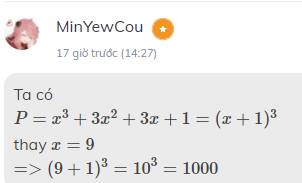Cho hình HCN có chiều dài bằng 6cm, chiều rộng bằng \(\dfrac{1}{2}\) chiều dài và chiều cao gấp 3 lần chiều rộng. Tính \(S_{\text{xq}}\) và \(S_{\text{tp}}\) và \(V\) của hình đó.
Hãy nhập câu hỏi của bạn vào đây, nếu là tài khoản VIP, bạn sẽ được ưu tiên trả lời.



\(\left(2+1\right)\left(2^2+1\right)\left(2^4+1\right)\left(2^8+1\right)\)
\(=\left(2^2-1\right)\left(2^2+1\right)\left(2^4+1\right)\left(2^8+1\right)\)
\(=\left(2^4-1\right)\left(2^4+1\right)\left(2^8+1\right)\)
\(=\left(2^8-1\right)\left(2^8+1\right)\)
\(=2^{16}-1\)

\(1+8.\left(3^2+1\right)\left(3^4+1\right)\left(3^8+1\right)-9^8\)
\(=1+\left(3^2-1\right).\left(3^2+1\right)\left(3^4+1\right)\left(3^8+1\right)-9^8\)
\(=1+\left(3^4-1\right)\left(3^4+1\right)\left(3^8+1\right)-9^8\)
\(=1+\left(3^8-1\right)\left(3^8+1\right)-9^8\)
\(=1+\left(3^8\right)^2-1-9^8=\left(3^2\right)^8-9^8=9^8-9^8=0\)

c) This makes no sense. What is quadrilateral ABCE while B, E, C are collinear? May be you mean ABCD but you make some mistake when typing.
ADCE is a parallelogram, therefore, \(CE//AD\) or \(BC//AD\)
Thus, we can easily prove that ABCD is a trapezoid.
Consider the triangle ABE, its height AH is also a median. This means ABE is an isosceles triangle, whose bisector is also AH. Thus, \(\widehat{BAH}=\widehat{EAH}\)
Clearly, we get \(\widehat{BAH}=\widehat{ECA}\left(=90^o-\widehat{B}\right)\), so, \(\widehat{EAH}=\widehat{ECA}\left(=\widehat{BAH}\right)\)
On the other hand, \(EC//AD\Rightarrow\widehat{ECA}=\widehat{CAD}\) (2 staggered angles)
Thus, \(\widehat{EAH}=\widehat{CAD}\left(=\widehat{ECA}\right)\) or \(\widehat{EAH}+\widehat{EAC}=\widehat{CAD}+\widehat{EAC}\) or \(\widehat{CAH}=\widehat{DAE}\)
ADCE is a parallelogram, therefore, \(\widehat{DAE}=\widehat{DCE}\), so, \(\widehat{CAH}=\widehat{DCE}\left(=\widehat{DAE}\right)\) or \(\widehat{CAH}=\widehat{DCB}\)
We also have \(\widehat{CAH}=\widehat{B}\left(=90^o-\widehat{ACB}\right)\), so \(\widehat{B}=\widehat{DCB}\left(=\widehat{CAH}\right)\)
Consider the trapezoid ABCD (AD//BC), it has \(\widehat{B}=\widehat{DCB}\), therefore, ABCD is an isosceles trapezoid.
d) It's pretty easy! Since ABE is an isosceles triangle, \(AE=AB\). Guess what? We've already had \(AB=15cm\). So, simply, we get \(AE=15cm\) !!!

I'll let you draw the figurr by yourself.
a) There are 3 trapezoid: BDEC, BDIC and BIEC.
b) Because \(DE//BC\), \(\widehat{DIB}=\widehat{IBC}\) (2 staggered angles)
We also have \(\widehat{IBC}=\widehat{IBD}\) (because BI is the bisector of \(\widehat{ABC}\)). Thus, IBD is an isosceles triangle, which means \(ID=BD\)
Similarly, we have \(IE=CE\). Form these, we have \(ID+IE=BD+CE\) or \(DE=BD+CE\)
And that's what we have to prove!

a) Xét tam giác HBA và tam giác ABC :
góc B chung
góc BHA = góc BAC (= 90 độ)
=> Tam giác HBA đồng dạng với tam giác ABC
b) Áp dụng định lí pytago vào tam giác vuông ABC, ta được :
AB^2 + AC^2 = BC^2
=> 15^2 + 20^2 = BC^2
=> BC^2 = 625
=> BC = 25 (cm)
Vì tam giác HBA đồng dạng với tam giác ABC
=> AH/AC = AB/BC
=> AH/20 = 15/25
=> AH = 20.15/25 = 12 (cm)
No one but you draw the figure.
a) Consider the right triangle ABC, which has \(\widehat{A}=90^o\), we have \(\widehat{B}+\widehat{C}=90^o\Leftrightarrow\widehat{C}=90^o-\widehat{B}\) (1)
On the other hand, the triangle ABC has the height AH, therefore, triangle HBA is also a right triangle \(\left(\widehat{AHB}=90^o\right)\)
Thus, we have \(\widehat{BAH}+\widehat{B}=90^o\Leftrightarrow\widehat{BAH}=90^o-\widehat{B}\) (2)
From (1) and (2), we get \(\widehat{HAB}=\widehat{C}\)
Consider the 2 triangles HAB and ABC, both of these triangles are right triangles, also, \(\widehat{HAB}=\widehat{C}\). Therefore, \(\Delta HAB~\Delta ABC\left(a.a\right)\)
b) Consider the right triangle ABC \(\left(\widehat{A}=90^o\right)\). According to the Pytagorean theorem, we have \(BC^2=AB^2+AC^2\Leftrightarrow BC=\sqrt{AB^2+AC^2}\)
Because \(AB=15cm;AC=20cm\), \(BC=\sqrt{15^2+20^2}=25\left(cm\right)\)
Triangle ABC rights at A, so \(S_{ABC}=\dfrac{1}{2}AB.AC\) (3)
Also, triangle ABC has the height AH, so \(S_{ABC}=\dfrac{1}{2}AH.BC\)(4)
From (3) and (4), we have \(\dfrac{1}{2}AH.BC=\dfrac{1}{2}AB.AC\left(=S_{ABC}\right)\Leftrightarrow AH.BC=AB.AC\)\(\Leftrightarrow AH=\dfrac{AB.AC}{BC}=\dfrac{15.20}{25}=12\left(cm\right)\)
So, \(BC=25cm\) and \(AH=12cm\)
c) What is the question? I can't see it.

a) Ta có: \(Q=12x-4x^2-11=-\left(4x^2-12x+9\right)-2=-\left(2x-3\right)^2-2< 0\)
\(\Rightarrow\)ĐPCM
b) Ta có: \(\left(a^3+b^3\right)\left(a^2+b^2\right)=a^5+b^5+a^3b^2+a^2b^3=a^5+b^5+a^2b^2\left(a+b\right)\)
Mà \(ab=1\Rightarrow\left(a^3+b^3\right)\left(a^2+b^2\right)=a^5+b^5+\left(a+b\right)\)
\(\Rightarrow a^5+b^5=\left(a^3+b^3\right)\left(a^2+b^2\right)-\left(a+b\right)\)
a) We have \(Q=12x-4x^2-11=-\left(4x^2-12x+9\right)-2=-\left(2x-3\right)^2-2\)Because \(-\left(2x-3\right)^2\le0\); \(-\left(2x-3\right)^2-2\le-2< 0\Leftrightarrow Q< 0\)
And that's the thing we have to prove.
b) Just expand the polynomial on the right side of the equality:
We have \(R=\left(a^3+b^3\right)\left(a^2+b^2\right)-\left(a+b\right)\) \(=a^5+b^5+a^3b^2+a^2b^3-\left(a+b\right)\)\(=a^5+b^5+a^2b^2\left(a+b\right)-\left(a+b\right)\)
On the other hand, \(ab=1\Leftrightarrow a^2b^2=1\)
Therefore, \(R=a^5+b^5+\left(a+b\right)-\left(a+b\right)=a^5+b^5=L\)
Thus, the quality was proved.

Chiều rộng hình hộp chữ nhật là : \(6\cdot\dfrac{1}{2}=3\left(cm\right)\)
Chiều cao hình hộp chữ nhật là : \(3\cdot3=9\left(cm\right)\)
\(S_{\text{xq}}\) là : \(\left(6+3\right)\cdot2\cdot9=162\left(cm^2\right)\)
\(S_{\text{tp}}\) là : \(162+2\left(6\cdot3\right)=198\left(cm^2\right)\)
\(V\) là : \(3\cdot6\cdot9=163\left(cm^3\right)\)
Chiều rộng hình HCN là:
6 : 2 = 3 ( cm )
Chiều cao hình HCN là :
3 x 3 = 9 ( cm )
Sxung quanh hình HCN là
( 6+3 ) x 2 x 9 = 162 ( cm2 )
Stoàn phần hình HCN là :
162 + ( 6 x 3 x 2 ) = 198 ( cm2 )